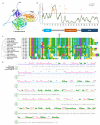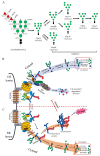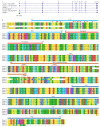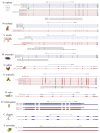Comprehensive Analysis of the Structure and Function of Peptide:N-Glycanase 1 and Relationship with Congenital Disorder of Deglycosylation
- PMID: 35565658
- PMCID: PMC9102325
- DOI: 10.3390/nu14091690
Comprehensive Analysis of the Structure and Function of Peptide:N-Glycanase 1 and Relationship with Congenital Disorder of Deglycosylation
Abstract
The cytosolic PNGase (peptide:N-glycanase), also known as peptide-N4-(N-acetyl-β-glucosaminyl)-asparagine amidase, is a well-conserved deglycosylation enzyme (EC 3.5.1.52) which catalyzes the non-lysosomal hydrolysis of an N(4)-(acetyl-β-d-glucosaminyl) asparagine residue (Asn, N) into a N-acetyl-β-d-glucosaminyl-amine and a peptide containing an aspartate residue (Asp, D). This enzyme (NGLY1) plays an essential role in the clearance of misfolded or unassembled glycoproteins through a process named ER-associated degradation (ERAD). Accumulating evidence also points out that NGLY1 deficiency can cause an autosomal recessive (AR) human genetic disorder associated with abnormal development and congenital disorder of deglycosylation. In addition, the loss of NGLY1 can affect multiple cellular pathways, including but not limited to NFE2L1 pathway, Creb1/Atf1-AQP pathway, BMP pathway, AMPK pathway, and SLC12A2 ion transporter, which might be the underlying reasons for a constellation of clinical phenotypes of NGLY1 deficiency. The current comprehensive review uncovers the NGLY1'ssdetailed structure and its important roles for participation in ERAD, involvement in CDDG and potential treatment for NGLY1 deficiency.
Keywords: ER associated degradation process; N-glycosylation; NFE2L1; NGLY1; congenital disorder of deglycosylation.
Conflict of interest statement
There were no competing interests between the authors and funding.
Figures









Similar articles
-
Structural and Functional Characterization of N-Glycanase-1 Pathogenic Variants.Cells. 2025 Jul 7;14(13):1036. doi: 10.3390/cells14131036. Cells. 2025. PMID: 40643555 Free PMC article.
-
NGLY1 Deficiency, a Congenital Disorder of Deglycosylation: From Disease Gene Function to Pathophysiology.Cells. 2022 Mar 29;11(7):1155. doi: 10.3390/cells11071155. Cells. 2022. PMID: 35406718 Free PMC article. Review.
-
The cytoplasmic peptide:N-glycanase (NGLY1) - Structure, expression and cellular functions.Gene. 2016 Feb 10;577(1):1-7. doi: 10.1016/j.gene.2015.11.021. Epub 2015 Nov 30. Gene. 2016. PMID: 26611529 Free PMC article. Review.
-
Transcriptome and functional analysis in a Drosophila model of NGLY1 deficiency provides insight into therapeutic approaches.Hum Mol Genet. 2018 Mar 15;27(6):1055-1066. doi: 10.1093/hmg/ddy026. Hum Mol Genet. 2018. PMID: 29346549 Free PMC article.
-
Development of new NGLY1 assay systems - toward developing an early screening method for NGLY1 deficiency.Glycobiology. 2024 Sep 30;34(11):cwae067. doi: 10.1093/glycob/cwae067. Glycobiology. 2024. PMID: 39206713 Free PMC article. Review.
Cited by
-
KCTD1 regulation of Adenylyl cyclase type 5 adjusts striatal cAMP signaling.Proc Natl Acad Sci U S A. 2024 Oct 22;121(43):e2406686121. doi: 10.1073/pnas.2406686121. Epub 2024 Oct 16. Proc Natl Acad Sci U S A. 2024. PMID: 39413138 Free PMC article.
-
PD-L1 deglycosylation promotes its nuclear translocation and accelerates DNA double-strand-break repair in cancer.Nat Commun. 2024 Aug 9;15(1):6830. doi: 10.1038/s41467-024-51242-8. Nat Commun. 2024. PMID: 39122729 Free PMC article.
-
Functional prediction of the potential NGLY1 mutations associated with rare disease CDG.Heliyon. 2024 Apr 6;10(8):e28787. doi: 10.1016/j.heliyon.2024.e28787. eCollection 2024 Apr 30. Heliyon. 2024. PMID: 38628705 Free PMC article.
-
Structural and Functional Characterization of N-Glycanase-1 Pathogenic Variants.Cells. 2025 Jul 7;14(13):1036. doi: 10.3390/cells14131036. Cells. 2025. PMID: 40643555 Free PMC article.
-
Nrf1 acts as a highly-conserved determinon for maintaining robust redox homeostasis in the eco-evo-devo process of life histories.Cell Stress. 2025 Jul 7;9:65-142. doi: 10.15698/cst2025.07.306. eCollection 2025. Cell Stress. 2025. PMID: 40703332 Free PMC article. Review.
References
-
- Enns G.M., Shashi V., Bainbridge M., Gambello M.J., Zahir F.R., Bast T., Crimian R., Schoch K., Platt J., Cox R., et al. Mutations in NGLY1 cause an inherited disorder of the endoplasmic reticulum-associated degradation pathway. Genet. Med. 2014;16:751–758. doi: 10.1038/gim.2014.22. - DOI - PMC - PubMed
Publication types
MeSH terms
Substances
Supplementary concepts
Grants and funding
LinkOut - more resources
Full Text Sources
Research Materials

